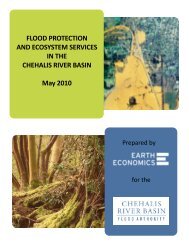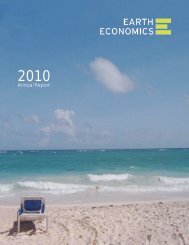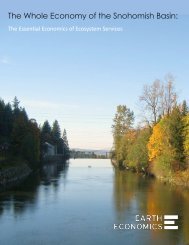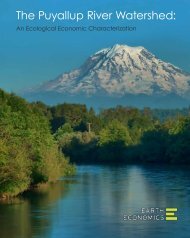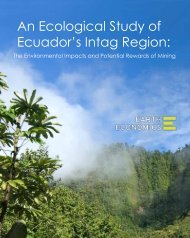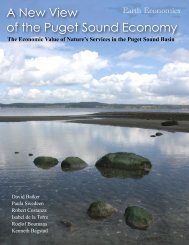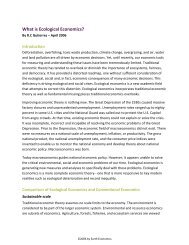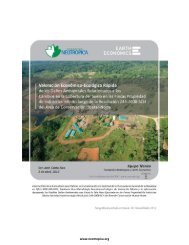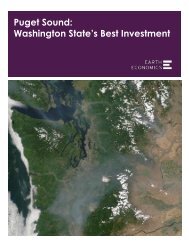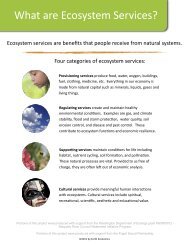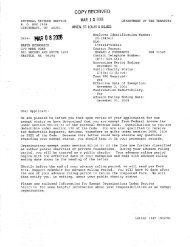The Spot Prawn Fishery: A Status Report - Earth Economics
The Spot Prawn Fishery: A Status Report - Earth Economics
The Spot Prawn Fishery: A Status Report - Earth Economics
You also want an ePaper? Increase the reach of your titles
YUMPU automatically turns print PDFs into web optimized ePapers that Google loves.
<strong>The</strong> <strong>Spot</strong> <strong>Prawn</strong> <strong>Fishery</strong>: A <strong>Status</strong> <strong>Report</strong><br />
sporadic, with low harvests. This is probably due<br />
to the fact that spot prawns historically were a<br />
supplemental source of income for salmon and<br />
halibut fishers (Koeneman and Botelho 2000c).<br />
Limited data from the 1960s suggest an annual<br />
harvest of 7,938 kilograms (17,464 lbs.) with a<br />
record catch of 17,690 kilograms (375,219 lbs.).<br />
Management was “passive” and markets existed<br />
for whole, fresh product or fresh tails.<br />
<strong>The</strong> spot prawn fishery became increasingly important<br />
to the fishing industry in the 1980s, with a<br />
resulting increase in both effort and landings.<br />
Average annual landings peaked at 170,554 kilograms<br />
(375,219 lbs.), and in the 1988–89 season<br />
130 permits were fished. In Prince William Sound<br />
the number of vessels participating in the fishery<br />
expanded ninefold between 1978 and 1987, with<br />
catches peaking in 1986 and then dropping precipitously,<br />
in part due to the Exxon Valdez oil spill.<br />
<strong>The</strong> fishery in Prince William Sound was closed<br />
by emergency order in 1990 due to low stock<br />
abundance. Experimental fishing in late 1991<br />
indicated “severely depressed stocks”; the fishery<br />
was closed in 1992 and remains closed today<br />
(Orensanz et al. 1998).<br />
Southeastern Alaska’s spot prawn catches were<br />
relatively small and the pace of fishing slow until<br />
the 1996–97 fishing season. Management reflected<br />
the nature of the fishery at that time. It was primarily<br />
“passive,” restricting only the number of pots<br />
fished and the mesh size used. Little funding or<br />
need for “active” management existed. <strong>The</strong> combination<br />
of growth in fishing effort, changing market<br />
conditions, and technological improvements drove<br />
commercial activity farther offshore or into other<br />
fishing areas. At this point, it became clear to management<br />
that a more structured management system<br />
was needed.<br />
<strong>The</strong> <strong>Spot</strong> <strong>Prawn</strong> Pot <strong>Fishery</strong><br />
<strong>The</strong> spot prawn fishery grew rapidly in the 1990s,<br />
when up to 248 permits were fished and catches<br />
peaked at 356,076 kilograms (783,367 lbs.). Extensive<br />
regulations were established at this time. Total<br />
season harvest from all districts was restricted at<br />
371,952 kilograms (818,294 lbs.). Mesh-size limits<br />
were set in order to allow the escape of prawns<br />
that were smaller than 30 mm (1.18 in.) in carapace<br />
length. <strong>The</strong> fishing season was restrained in<br />
order to prevent fishing during the egg-hatching<br />
period (varies geographically, but typically falls<br />
between late February and mid-May) and during<br />
the summer, when prawns molt and their shells<br />
are soft. In 1997, a fishing season of October 1 to<br />
February 28 was implemented.<br />
In late 1994 the first catcher-processor 4 came<br />
into the fishery, and in the 1995–96 season five<br />
floating-processors 5 and additional catcherprocessors<br />
participated. Pot catch efficiency and<br />
the pace of the fishing greatly increased at this<br />
time. <strong>The</strong>re was a shift from “tailed” to unsorted,<br />
whole product resulting in a moderate increase<br />
in value. <strong>The</strong> change in preferred product was significant<br />
in that it allowed fishers to spend less time<br />
sorting and processing prawns, and more time<br />
pulling pots or processing frozen-at-sea (FAS)<br />
product. <strong>The</strong> spot prawn fishery then became<br />
a major source of income for many fishers.<br />
Overcapitalization concerns led to discussions<br />
about the development and implementation of a<br />
limited-entry program to control effort and capacity.<br />
<strong>The</strong> limited-entry program was announced in<br />
late 1995 and established in 1996. Participation<br />
was restricted to 332 permits, the first of which<br />
were issued in February 1998. <strong>The</strong> announcement<br />
of this program led to speculative fishing behavior,<br />
and the actual number of permits fished peaked at<br />
353 in 1995. As a result, the ability of the program<br />
to actually control fishing effort was directly affected.<br />
To date, 309 permits have been issued: 155 transferable,<br />
154 non-transferable. For the 2000–01 fishing<br />
season, 168 permits to fish were registered.<br />
Guideline Harvest Levels 6 (GHLs) were instituted<br />
in 1997 for southeastern Alaska’s fishing districts.<br />
<strong>The</strong> GHLs were based on historical catches from<br />
the 1990–91 to 1994–95 fishing seasons. Due to the<br />
fact that GHLs are based on historical catch records,<br />
managers believe that they may not relate to such<br />
biological parameters as spawner abundance or<br />
recruitment strength. This is especially the case in<br />
southeastern Alaska, where the GHLs are based on<br />
only five years of data from a fishery that continues<br />
to exhibit increases in fishing effort and efficiency.<br />
Similarly, catch-per-unit-effort data may not<br />
reflect the fishery’s actual biomass. Improvements<br />
__________________________________________________________<br />
4 Catcher-processors are defined in Alaska Commercial Fishing<br />
Regulations (2000–2002) as “a vessel from which shrimp are caught and<br />
processed on board that vessel and from which no shrimp caught on<br />
other vessels was purchased or processed” (p. 84).<br />
5 A floating-processor is defined by the Alaska Commercial Fishing<br />
Regulations (2000–2002) as “a vessel that purchases and processes<br />
shrimp delivered to it by other vessels” (p. 85).<br />
6 <strong>The</strong> Alaska Commercial Fishing Regulations (2000–2002) define<br />
Guideline Harvest Levels as the “preseason estimated level of allowable<br />
fish harvest which will not jeopardize the sustained yield of the<br />
fish stocks” (p. 63).<br />
8



